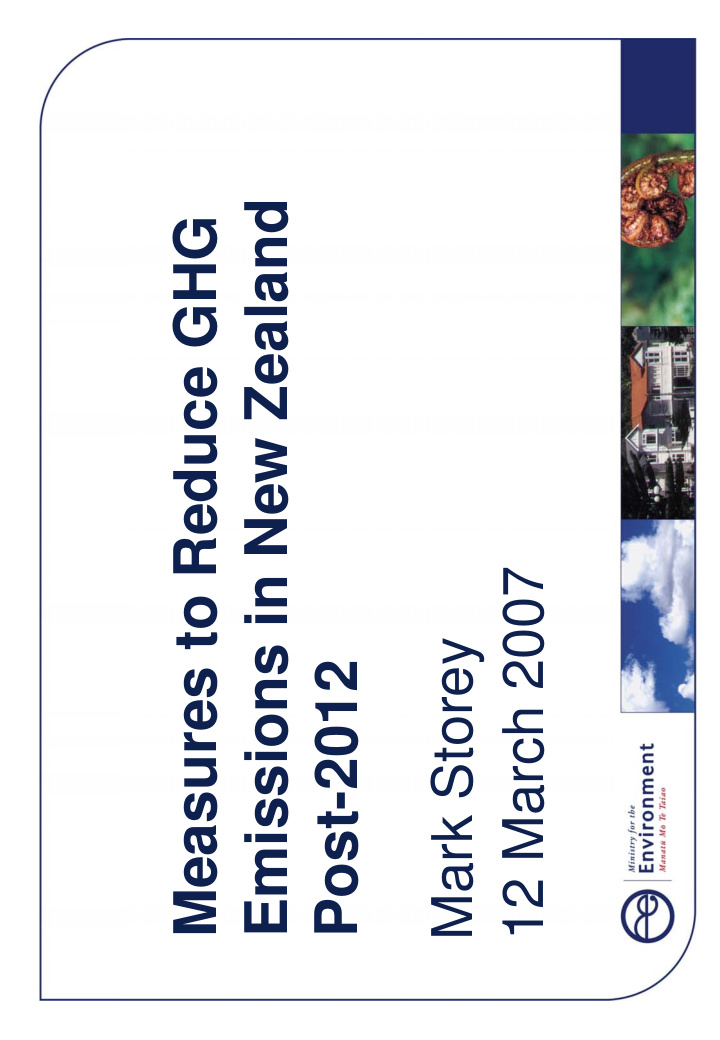



Emissions in New Zealand Measures to Reduce GHG 12 March 2007 Mark Storey Post-2012
New Zealand’s Choices: Architecture • Sectoral versus economy-wide approaches • Costs borne by emitters/consumers versus taxpayers • Price-based versus regulatory measures – If price-based measures, then use of emissions trading versus charges • Certainty versus flexibility 2
Climate Change Mitigation Measures Directive Price-Based Technology & Regulation Measures Reporting Emissions Trading Resource Research & • Cap and Trade Management Act Development • Baseline and Credit • Offsets Trading Greenhouse Gas Technology Electricity Act Charge Transfer & Dissemination Financial Incentives • Capital Subsidies Other Regulatory Emissions • Tax Incentives Vehicle Reporting • Financing Programmes • Preferential Pricing
Key Questions • Under what circumstances would trading be preferable to a charge or regulations post-2012? • What type of trading model(s) would work in NZ? • If NZ pursued broad price-based measures, which sectors should participate… – As points of obligation? – As sources of tradable offsets? • When should the government make decisions? 4
Key messages • New Zealand needs to compete in an emissions- constrained world in the longer-term. • Broad price-based measures should be part of the post- 2012 solution – but should fit the New Zealand context. • Different sectors/entities may require different transitional paths to emissions pricing. • We will benefit from both directional certainty and flexibility. • Significant action to mitigate climate change cannot wait for the determination of post-2012 measures. 5
Consultation • Further stakeholder meetings in early February 2007 • Submissions close on 30 March 2007 • Paper and submission template available on the website: – www.climatechange.govt.nz • For more information, contact: – climatechange@mfe.govt.nz 6
1. Future international policy • Stabilisation requires significant reductions. • Reducing global emissions will have an economic cost – but far less than the cost of inaction ( Stern Review ). • We don’t know the post-2012 international policy framework; countries are discussing many options. 7
1. Future international policy • We can make educated assumptions: – More countries and deeper efforts – Emissions pricing and emissions trading – Trade consequences for inaction. • New Zealand needs to prepare to bear this cost, reduce emissions, and compete. 8
3. What post-2012 measures suit NZ? • The paper focuses on two price-based measures: – Emissions trading – Greenhouse gas charges • It also considers other approaches: – Directive regulations (eg, RMA) – Emission reduction agreements 9
4. Gov’t decisions on post-2012 policy • Key government decisions: – Which measures to apply, and to whom – The stringency of measures – When to introduce measures • Options: – Define architecture of measures now, but details (stringency, coverage, timing) later – Define principles now, but measures later 10
Conclusions • The government has stated a preference for applying efficient price-based measures broadly across the economy post-2012. • Price-based measures can be designed to suit New Zealand’s national interests. • Different sectors/entities may require different transitional paths to emissions pricing. • No decisions have been made. • We want to hear your views! 11
Consultation • Further stakeholder meetings in early February 2007 • Submissions close on 30 March 2007 • Paper and submission template available on the website: – www.climatechange.govt.nz • For more information, contact: – climatechange@mfe.govt.nz 12
Emissions trading offers more flexibility Emissions Trading GHG Charges Reduce Emissions Reduce Emissions (Sell/Bank Excess Units) Surrender Allocated Units Purchase Units at Pay Charge Auction Purchase Units in the Trading Market Pay Penalty Pay Penalty
Baseline and Credit Trading Business-as-usual Emission Level Allocated Baseline Actual Emissions Time A B C Emissions ”credits” Emissions ”debits” Source: Australian Greenhouse Office
Recommend
More recommend